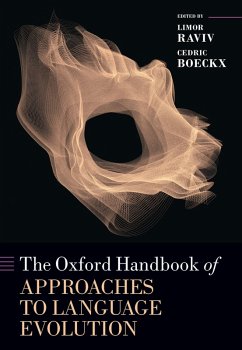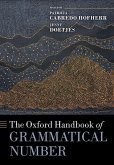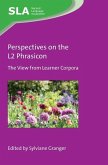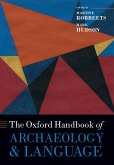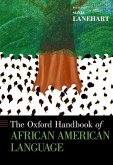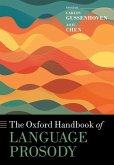The Oxford Handbook of Approaches to Language Evolution
Herausgeber: Raviv, Limor; Boeckx, Cedric
The Oxford Handbook of Approaches to Language Evolution
Herausgeber: Raviv, Limor; Boeckx, Cedric
- Gebundenes Buch
- Merkliste
- Auf die Merkliste
- Bewerten Bewerten
- Teilen
- Produkt teilen
- Produkterinnerung
- Produkterinnerung
This handbook provides a detailed account of the many methodological considerations and approaches in the field of language evolution. Each chapter highlights a particular methodology and outlines a question or set of questions that can be addressed using that methodology, illustrated by a key example from the recent literature.
Andere Kunden interessierten sich auch für
![The Oxford Handbook of Grammatical Number The Oxford Handbook of Grammatical Number]() The Oxford Handbook of Grammatical Number224,99 €
The Oxford Handbook of Grammatical Number224,99 €![Perspectives on the L2 Phrasicon Perspectives on the L2 Phrasicon]() Perspectives on the L2 Phrasicon165,99 €
Perspectives on the L2 Phrasicon165,99 €![The Oxford Handbook of Archaeology and Language The Oxford Handbook of Archaeology and Language]() The Oxford Handbook of Archaeology and Language288,99 €
The Oxford Handbook of Archaeology and Language288,99 €![The Oxford Handbook of Ritual Language The Oxford Handbook of Ritual Language]() The Oxford Handbook of Ritual Language181,99 €
The Oxford Handbook of Ritual Language181,99 €![Oxford Handbook of African American Language Oxford Handbook of African American Language]() Oxford Handbook of African American Language225,99 €
Oxford Handbook of African American Language225,99 €![The Oxford Handbook of Language Prosody The Oxford Handbook of Language Prosody]() The Oxford Handbook of Language Prosody224,99 €
The Oxford Handbook of Language Prosody224,99 €![The Oxford Handbook of the French Language The Oxford Handbook of the French Language]() The Oxford Handbook of the French Language186,99 €
The Oxford Handbook of the French Language186,99 €-
-
-
This handbook provides a detailed account of the many methodological considerations and approaches in the field of language evolution. Each chapter highlights a particular methodology and outlines a question or set of questions that can be addressed using that methodology, illustrated by a key example from the recent literature.
Produktdetails
- Produktdetails
- Verlag: Oxford University Press
- Seitenzahl: 656
- Erscheinungstermin: 30. September 2025
- Englisch
- Abmessung: 224mm x 175mm x 33mm
- Gewicht: 1383g
- ISBN-13: 9780192886491
- ISBN-10: 0192886495
- Artikelnr.: 73514419
- Herstellerkennzeichnung
- Libri GmbH
- Europaallee 1
- 36244 Bad Hersfeld
- gpsr@libri.de
- Verlag: Oxford University Press
- Seitenzahl: 656
- Erscheinungstermin: 30. September 2025
- Englisch
- Abmessung: 224mm x 175mm x 33mm
- Gewicht: 1383g
- ISBN-13: 9780192886491
- ISBN-10: 0192886495
- Artikelnr.: 73514419
- Herstellerkennzeichnung
- Libri GmbH
- Europaallee 1
- 36244 Bad Hersfeld
- gpsr@libri.de
Limor Raviv leads the Language Evolution and Adaptation in Diverse Situations (LEADS) group at the Max Planck Institute for Psycholinguistics, and is also a part-time lecturer in social interaction at the University of Glasgow. Her work simulates language evolution and diversification de novo and in silico by using a range of experimental and computational tools. She aims to uncover the major social, cognitive, and environmental pressures that shape human languages past and present, and to link core aspects of learning, cultural evolution, and ecology to explain the emergence and cross-linguistic variation of languages. Cedric Boeckx is a research professor at ICREA, and the principal investigator of the Cognitive Biology of Language research group at the University of Barcelona, as well as a member of the University of Barcelona Institutes of Neuroscience and of Complex Systems. His current research focuses on the neurobiological foundations of the human language faculty, with special emphasis on evolutionary issues. His work is intended to facilitate integration among disciplines with the aim of achieving both better experimental testing of theoretical hypotheses and more solid interpretations of experimental findings.
* Introduction
* Part I. Human data
* 1: Monica Tamariz and Aliki Papa: Iterated learning experiments
* 2: Shira Tal, Inbal Arnon, and Jennifer Culbertson: Artificial
language learning
* 3: Thomas Franz Müller and Limor Raviv: Communication experiments:
Social interaction in the formation of novel communication systems
* 4: Jonas Nölle and David Peeters: Virtual reality as a tool to study
language evolution
* 5: Vera Kempe and Marisa Casillas: Studying child-directed speech
* 6: Stefan Hartmann and Michael Pleyer: Corpus-based approaches to
evolutionary dynamics in language
* 7: Caleb Everett: Adaptation
* 8: Wendy Sandler, Svetlana Dachkovsky, and Rose Stamp: The evolution
of the grammar of the body in sign languages
* 9: Danielle Naegeli and Marieke Schouwstra: Silent gesture: Gesture
studies with hearing participants
* 10: Anita Slonimska and Asli Özyürek: Methods to study evolution of
iconicity in sign languages
* 11: Damian Blasi, Felicia Bisnath, and Pui Yiu Szeto: The study of
Creole languages
* 12: Juan Moriano, Cedrix Boeckx, and Martin Kuhlwilm: Paleogenomics:
A window into the genetic basis of derived traits in Homo sapiens
* 13: Yakov Pichkar and Nicole Creanza: Joint analysis of human
linguistic and genomic variation
* 14: Maxime Derex and Charlotte Brand: Studying long-term evolutionary
processes over short time scales: Methods in cumulative cultural
evolution
* 15: Isobel Wisher and Kristian Tylén: An integrative approach to
early symbolic evolution: Experimenting with the past
* Part II. Simulations
* 16: Vanessa Ferdinand: The Bayesian iterated learning model
* 17: Xenia Ohmer and Christine Cuskley: Communication games: Modelling
language evolution through dyadic agent interactions
* 18: Katie Mudd and Bart de Boer: Computational methods for language
variation and convergence
* 19: Mathieu Rita, Paul Michel, Rahma Chaabouni, Olivier Pietquin,
Emmanuel Dupoux, and Florian Strub: Language evolution with deep
learning
* 20: Nicolas Cambier and Roman Miletitch: Task-driven language
evolution with swarm robotics
* 21: Chundra Cathcart and Balthasar Bickel: Linguistic evolution in
time and space: Addressing the methodological challenges
* 22: Francis Mollica and Noga Zaslavsky: Information-theoretic and
machine-learning methods for semantic categorization
* 23: Kateryna Krykoniuk and Seán G. Roberts: Causal graphs as a tool
for exploring language evolution
* Part III. Animal data
* 24: Marco Gamba and Chiara De Gregorio: Observational work
* 25: Erica A. Cartmill, Emilie Genty, Kirsty E. Graham, Charlotte
Grund, and Catherine Hobaiter: Re-imagining great ape gesture
(coding)
* 26: Simone Pika and Ray Wilkinson: Evolutionary roots of human
cooperative communication: Using the CA-assisted comparative approach
for quantitative and qualitative analyses
* 27: Marlen Fröhlich and Carel P. van Schaik: From species- to
individual-level comparisons: What variation in great ape
communication can tell us about language evolution
* 28: Mélissa Berthet, Maël Leroux, Simon W. Townsend, and Stuart K.
Watson: ethods of examining the processing and production of
rule-based sequences in animals
* 29: Daria Valente and Andrea Ravignani: Bioacoustics and rhythm
* 30: Ronald J. Planer, Elisa Bandini, and Claudio Tennie: Hominin tool
evolution and its (surprising) relation to language origins
* 31: Nicole Eichert and Rogier B. Mars: Comparative neuroimaging to
study the neural infrastructure for language
* 32: Toshitaka N. Suzuki: How to study animal syntax
* Part I. Human data
* 1: Monica Tamariz and Aliki Papa: Iterated learning experiments
* 2: Shira Tal, Inbal Arnon, and Jennifer Culbertson: Artificial
language learning
* 3: Thomas Franz Müller and Limor Raviv: Communication experiments:
Social interaction in the formation of novel communication systems
* 4: Jonas Nölle and David Peeters: Virtual reality as a tool to study
language evolution
* 5: Vera Kempe and Marisa Casillas: Studying child-directed speech
* 6: Stefan Hartmann and Michael Pleyer: Corpus-based approaches to
evolutionary dynamics in language
* 7: Caleb Everett: Adaptation
* 8: Wendy Sandler, Svetlana Dachkovsky, and Rose Stamp: The evolution
of the grammar of the body in sign languages
* 9: Danielle Naegeli and Marieke Schouwstra: Silent gesture: Gesture
studies with hearing participants
* 10: Anita Slonimska and Asli Özyürek: Methods to study evolution of
iconicity in sign languages
* 11: Damian Blasi, Felicia Bisnath, and Pui Yiu Szeto: The study of
Creole languages
* 12: Juan Moriano, Cedrix Boeckx, and Martin Kuhlwilm: Paleogenomics:
A window into the genetic basis of derived traits in Homo sapiens
* 13: Yakov Pichkar and Nicole Creanza: Joint analysis of human
linguistic and genomic variation
* 14: Maxime Derex and Charlotte Brand: Studying long-term evolutionary
processes over short time scales: Methods in cumulative cultural
evolution
* 15: Isobel Wisher and Kristian Tylén: An integrative approach to
early symbolic evolution: Experimenting with the past
* Part II. Simulations
* 16: Vanessa Ferdinand: The Bayesian iterated learning model
* 17: Xenia Ohmer and Christine Cuskley: Communication games: Modelling
language evolution through dyadic agent interactions
* 18: Katie Mudd and Bart de Boer: Computational methods for language
variation and convergence
* 19: Mathieu Rita, Paul Michel, Rahma Chaabouni, Olivier Pietquin,
Emmanuel Dupoux, and Florian Strub: Language evolution with deep
learning
* 20: Nicolas Cambier and Roman Miletitch: Task-driven language
evolution with swarm robotics
* 21: Chundra Cathcart and Balthasar Bickel: Linguistic evolution in
time and space: Addressing the methodological challenges
* 22: Francis Mollica and Noga Zaslavsky: Information-theoretic and
machine-learning methods for semantic categorization
* 23: Kateryna Krykoniuk and Seán G. Roberts: Causal graphs as a tool
for exploring language evolution
* Part III. Animal data
* 24: Marco Gamba and Chiara De Gregorio: Observational work
* 25: Erica A. Cartmill, Emilie Genty, Kirsty E. Graham, Charlotte
Grund, and Catherine Hobaiter: Re-imagining great ape gesture
(coding)
* 26: Simone Pika and Ray Wilkinson: Evolutionary roots of human
cooperative communication: Using the CA-assisted comparative approach
for quantitative and qualitative analyses
* 27: Marlen Fröhlich and Carel P. van Schaik: From species- to
individual-level comparisons: What variation in great ape
communication can tell us about language evolution
* 28: Mélissa Berthet, Maël Leroux, Simon W. Townsend, and Stuart K.
Watson: ethods of examining the processing and production of
rule-based sequences in animals
* 29: Daria Valente and Andrea Ravignani: Bioacoustics and rhythm
* 30: Ronald J. Planer, Elisa Bandini, and Claudio Tennie: Hominin tool
evolution and its (surprising) relation to language origins
* 31: Nicole Eichert and Rogier B. Mars: Comparative neuroimaging to
study the neural infrastructure for language
* 32: Toshitaka N. Suzuki: How to study animal syntax
* Introduction
* Part I. Human data
* 1: Monica Tamariz and Aliki Papa: Iterated learning experiments
* 2: Shira Tal, Inbal Arnon, and Jennifer Culbertson: Artificial
language learning
* 3: Thomas Franz Müller and Limor Raviv: Communication experiments:
Social interaction in the formation of novel communication systems
* 4: Jonas Nölle and David Peeters: Virtual reality as a tool to study
language evolution
* 5: Vera Kempe and Marisa Casillas: Studying child-directed speech
* 6: Stefan Hartmann and Michael Pleyer: Corpus-based approaches to
evolutionary dynamics in language
* 7: Caleb Everett: Adaptation
* 8: Wendy Sandler, Svetlana Dachkovsky, and Rose Stamp: The evolution
of the grammar of the body in sign languages
* 9: Danielle Naegeli and Marieke Schouwstra: Silent gesture: Gesture
studies with hearing participants
* 10: Anita Slonimska and Asli Özyürek: Methods to study evolution of
iconicity in sign languages
* 11: Damian Blasi, Felicia Bisnath, and Pui Yiu Szeto: The study of
Creole languages
* 12: Juan Moriano, Cedrix Boeckx, and Martin Kuhlwilm: Paleogenomics:
A window into the genetic basis of derived traits in Homo sapiens
* 13: Yakov Pichkar and Nicole Creanza: Joint analysis of human
linguistic and genomic variation
* 14: Maxime Derex and Charlotte Brand: Studying long-term evolutionary
processes over short time scales: Methods in cumulative cultural
evolution
* 15: Isobel Wisher and Kristian Tylén: An integrative approach to
early symbolic evolution: Experimenting with the past
* Part II. Simulations
* 16: Vanessa Ferdinand: The Bayesian iterated learning model
* 17: Xenia Ohmer and Christine Cuskley: Communication games: Modelling
language evolution through dyadic agent interactions
* 18: Katie Mudd and Bart de Boer: Computational methods for language
variation and convergence
* 19: Mathieu Rita, Paul Michel, Rahma Chaabouni, Olivier Pietquin,
Emmanuel Dupoux, and Florian Strub: Language evolution with deep
learning
* 20: Nicolas Cambier and Roman Miletitch: Task-driven language
evolution with swarm robotics
* 21: Chundra Cathcart and Balthasar Bickel: Linguistic evolution in
time and space: Addressing the methodological challenges
* 22: Francis Mollica and Noga Zaslavsky: Information-theoretic and
machine-learning methods for semantic categorization
* 23: Kateryna Krykoniuk and Seán G. Roberts: Causal graphs as a tool
for exploring language evolution
* Part III. Animal data
* 24: Marco Gamba and Chiara De Gregorio: Observational work
* 25: Erica A. Cartmill, Emilie Genty, Kirsty E. Graham, Charlotte
Grund, and Catherine Hobaiter: Re-imagining great ape gesture
(coding)
* 26: Simone Pika and Ray Wilkinson: Evolutionary roots of human
cooperative communication: Using the CA-assisted comparative approach
for quantitative and qualitative analyses
* 27: Marlen Fröhlich and Carel P. van Schaik: From species- to
individual-level comparisons: What variation in great ape
communication can tell us about language evolution
* 28: Mélissa Berthet, Maël Leroux, Simon W. Townsend, and Stuart K.
Watson: ethods of examining the processing and production of
rule-based sequences in animals
* 29: Daria Valente and Andrea Ravignani: Bioacoustics and rhythm
* 30: Ronald J. Planer, Elisa Bandini, and Claudio Tennie: Hominin tool
evolution and its (surprising) relation to language origins
* 31: Nicole Eichert and Rogier B. Mars: Comparative neuroimaging to
study the neural infrastructure for language
* 32: Toshitaka N. Suzuki: How to study animal syntax
* Part I. Human data
* 1: Monica Tamariz and Aliki Papa: Iterated learning experiments
* 2: Shira Tal, Inbal Arnon, and Jennifer Culbertson: Artificial
language learning
* 3: Thomas Franz Müller and Limor Raviv: Communication experiments:
Social interaction in the formation of novel communication systems
* 4: Jonas Nölle and David Peeters: Virtual reality as a tool to study
language evolution
* 5: Vera Kempe and Marisa Casillas: Studying child-directed speech
* 6: Stefan Hartmann and Michael Pleyer: Corpus-based approaches to
evolutionary dynamics in language
* 7: Caleb Everett: Adaptation
* 8: Wendy Sandler, Svetlana Dachkovsky, and Rose Stamp: The evolution
of the grammar of the body in sign languages
* 9: Danielle Naegeli and Marieke Schouwstra: Silent gesture: Gesture
studies with hearing participants
* 10: Anita Slonimska and Asli Özyürek: Methods to study evolution of
iconicity in sign languages
* 11: Damian Blasi, Felicia Bisnath, and Pui Yiu Szeto: The study of
Creole languages
* 12: Juan Moriano, Cedrix Boeckx, and Martin Kuhlwilm: Paleogenomics:
A window into the genetic basis of derived traits in Homo sapiens
* 13: Yakov Pichkar and Nicole Creanza: Joint analysis of human
linguistic and genomic variation
* 14: Maxime Derex and Charlotte Brand: Studying long-term evolutionary
processes over short time scales: Methods in cumulative cultural
evolution
* 15: Isobel Wisher and Kristian Tylén: An integrative approach to
early symbolic evolution: Experimenting with the past
* Part II. Simulations
* 16: Vanessa Ferdinand: The Bayesian iterated learning model
* 17: Xenia Ohmer and Christine Cuskley: Communication games: Modelling
language evolution through dyadic agent interactions
* 18: Katie Mudd and Bart de Boer: Computational methods for language
variation and convergence
* 19: Mathieu Rita, Paul Michel, Rahma Chaabouni, Olivier Pietquin,
Emmanuel Dupoux, and Florian Strub: Language evolution with deep
learning
* 20: Nicolas Cambier and Roman Miletitch: Task-driven language
evolution with swarm robotics
* 21: Chundra Cathcart and Balthasar Bickel: Linguistic evolution in
time and space: Addressing the methodological challenges
* 22: Francis Mollica and Noga Zaslavsky: Information-theoretic and
machine-learning methods for semantic categorization
* 23: Kateryna Krykoniuk and Seán G. Roberts: Causal graphs as a tool
for exploring language evolution
* Part III. Animal data
* 24: Marco Gamba and Chiara De Gregorio: Observational work
* 25: Erica A. Cartmill, Emilie Genty, Kirsty E. Graham, Charlotte
Grund, and Catherine Hobaiter: Re-imagining great ape gesture
(coding)
* 26: Simone Pika and Ray Wilkinson: Evolutionary roots of human
cooperative communication: Using the CA-assisted comparative approach
for quantitative and qualitative analyses
* 27: Marlen Fröhlich and Carel P. van Schaik: From species- to
individual-level comparisons: What variation in great ape
communication can tell us about language evolution
* 28: Mélissa Berthet, Maël Leroux, Simon W. Townsend, and Stuart K.
Watson: ethods of examining the processing and production of
rule-based sequences in animals
* 29: Daria Valente and Andrea Ravignani: Bioacoustics and rhythm
* 30: Ronald J. Planer, Elisa Bandini, and Claudio Tennie: Hominin tool
evolution and its (surprising) relation to language origins
* 31: Nicole Eichert and Rogier B. Mars: Comparative neuroimaging to
study the neural infrastructure for language
* 32: Toshitaka N. Suzuki: How to study animal syntax

